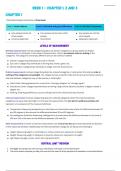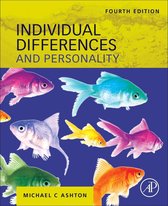Week 1 – Chapter 1, 2 and 3
Chapter 1
Personality Analysis can be done in three levels:
Level 1: Human Nature Level 2: Individual and group differences Level 3: Individual Uniqueness
How people are like all How people are like some other How people are not like
other people people. other people
Universal Approach Nomothetic Idiographic Approach
Levels of measurement
Nominal measurement involves categorizing data into distinct categories or groups based on shared
characteristics or attributes. In this level of measurement, there is no inherent order or ranking of the
categories. The categories are simply different and can be named or labeled.
Gender: Categorizing individuals as male or female.
Eye Color: Categorizing individuals as having blue, brown, green, etc.
Marital Status: Categorizing individuals as single, married, divorced, etc
Ordinal measurement involves categorizing data into ordered categories or ranks where the relative order or
ranking of the categories is meaningful. The categories have a specific order, but the actual numerical values or
intervals between categories may not be precise or meaningful.
Likert Scale: Rating agreement on a scale from "strongly disagree" to "strongly agree."
Educational Level: Categorizing individuals as having a high school diploma, bachelor's degree, master's
degree, etc.
Ranking: Ordering preferences, such as ranking movies from favorite to least favorite.
Interval measurement involves categorizing data into ordered categories where the intervals between
categories are equal and meaningful. In this level of measurement, the zero point is arbitrary and does not
represent a true absence of the measured attribute.
Temperature: Measuring temperature on the Celsius or Fahrenheit scale, where the difference between 10
and 20 degrees is the same as the difference between 20 and 30 degrees.
IQ (Intelligence Quotient): Measuring intelligence on a scale where the difference between an IQ score of
100 and 110 is the same as the difference between 110 and 120.
Ratio measurement is similar to interval measurement, but it has a true zero point that represents an absence
of the measured attribute. Additionally, the intervals between categories are equal and meaningful.
Height: Measuring height in centimeters or inches, where zero represents no height.
Weight: Measuring weight in kilograms or pounds, where zero represents no weight.
Age: Measuring age in years, where zero represents birth.
Central limit theorem
1. the bigger the sample size, the more your distribution will equal a normal distribution.
2. The more random samples you take, the more will the mean of all the samples will resemble a normal distribution.
, Correlation coefficient
Reliability Validity
Refers to the consistency and Validity refers to the accuracy and meaningfulness
stability of a measurement tool or of a measurement. It assesses whether the
instrument. measurement tool or instrument actually
measures what it intends to measure and whether
A reliable measure should yield
the results are meaningful and applicable to the
similar results each time it is used.
research question or the construct being studied.
Types of reliability:
Test-retest reliability ⟶ Is a measure used to assess the consistency or stability of a measurement or test
over time. It examines whether the same results or scores are obtained when the same test or
measurement is administered to the same group of individuals on two or more separate occasions
Inter-rater reliability ⟶ determines the degree to which different observers or raters produce similar or
consistent results when assessing the same thing.
Internal consistency ⟶ is a measure of reliability that assesses the extent to which items or questions
within a measurement instrument (such as a questionnaire or survey) are consistent or measure the same
underlying construct or concept.
Types of validity:
Content validity ⟶ It assesses whether the items or questions in the instrument are relevant,
representative, and comprehensive in measuring the intended construct.
Criterion validity ⟶ It evaluates whether the scores obtained from the measurement instrument
accurately predict or correspond to the scores obtained from a recognized criterion measure.
if you have developed a new intelligence test, criterion validity would involve comparing the scores
obtained from your test with those obtained from an established intelligence test that is widely
accepted as a valid measure of intelligence.
Construct validity ⟶ Construct validity evaluates whether a measurement instrument accurately
measures the theoretical construct or concept it claims to measure.
Chapter 2
,Personality
A personality trait refers to differences among individuals in a typical tendency to feel behave, or think in some
conceptually related ways, across a variety of relevant situations and across some fairly long period of time.
1. Differences among individuals: people differ in trait dimensions.
2. In a Typical tendency to behave, think or feel.
3. “Conceptually related”= two personality traits such as "conscientiousness" and "diligence" are
conceptually related because they both describe a tendency towards being responsible, reliable, and
hardworking.
4. Across a variety of relevant situations (tendency to display similar patterns of behavior, thoughts, and
emotions in different contexts that are relevant to their personality traits).
5. Tendency to display similar patterns of behavior, thoughts, and emotions over a significant duration of
time, typically years or even decades.
Personality is also: mental abilities (maximum instead of typical behavior), values ( more abstract than personality =
importance) and interests (more concrete than personality = preferences)
Does personality exist?
Walter Mischel (1968) + Hartshorne & may
Cross-situational consistency of conscientiousness. (Class attendance/notes/neatness…)
Total of 19 behaviors (no consistency of behaviors)
Found very low correlation between Personality and behaviors (There is no consistency in a person’s
conscientious behavior in different situations)
Highly critiqued the concept of personality traits.
But what mediates or at least moderates a reaction in any given situation?
1. The situation (the environment itself has a great impact in our behavior)
2. The interaction between persons and situations (people can evoke, influence and select situations)
Personality traits can be measured in two different questionnaire format:
Structured Questionnaires Unstructured Questionnaires
Has a closed ending Has an open ending
“I exercise a lot” Tell me about the parties you like the most
Either rank it on a scale/true or false
3 strategies to create a personality inventory
Empirical strategy: Multi-phasic Personality Inventory (MMPI-3)
⟶ Construct a questionnaire based on items that show relationships with other indicators of the trait.
, ⟶ Solely based on observations (research hypothesis/content do not play a role at all)
If research shows "i like to shave with a fork" is highly correlated with IQ, than this will be a conclusion.
The ES Examines relationship between items with outside variables that indicate levels of a certain trait
⟶ Distinguish between a control group and a criterion group to identify items that differentiate between them.
⟶ Begin with a large pool of items and narrow down the selection based on empirical evidence.
Factor Analysis Strategy:
⟶ Analyze a large and diverse pool of items along with a sizable group of individuals.
FAS examines which trait is being measured by a factor and which traits belong to each factor.
⟶ Use factor analysis to identify underlying factors or dimensions
⟶ Group items together based on their shared variance, placing highly correlated items in the same factor.
⟶ Gain insights into the specific traits associated with each factor.
Rational Strategy: Based on theories and rational thinking
⟶ The rational strategy involves developing items specifically for the purpose of assessing the trait being measured
⟶ RS will usually deduce which variables may be significant and look for high correlation between those items.
⟶ Seek expert opinions or rankings to ensure item relevance.
So whats the difference between ES and RS?
In the RS items are chosen based on how strongly they relate to each other.
Whereas the ES chooses items based on strong relation with outside variables
Comparison between 3 strategies
Results appear to be similar between all of them, however...
RS seems to be the most valid one and the easiest to implement.
Thats why questionnaires are based on Rational Strategy
However... the overall optimum analysis would add two other types of strategy to improve validity.
self and observer reports on personality inventory scales
Seen as very useful, since self-reports may be subjective. The usage of observer-reports will allow the
confirmation or falsification of the self-reports.
Agreement between self and observer reports
The correlation between self and observer reports can be used to judge the overall content validity of a PNS.
Usually, this correlation is high, indicating that convergent validity is also high on the PNS.
The correlations tend to be high when the self and observer know each other ⟶ r = 0.6
The correlations tend to be low when the self and observer do not know each other ⟶ r = 0.2/3
wHY DO THEY TEND TO Agree?
The self and Observer may have the same distorted view about a trait. Adding a second observer (or more)
that is not as well acquainted with the observed person can give an indication of whether the reports are





